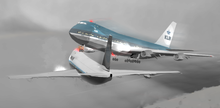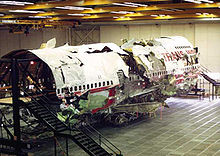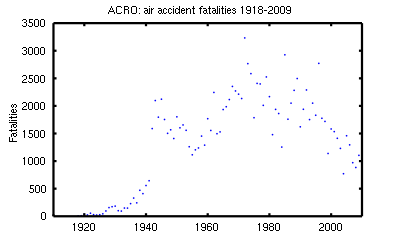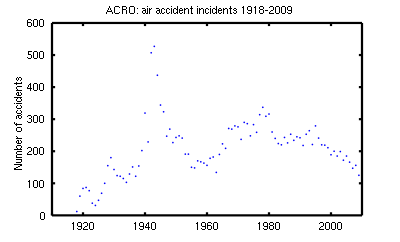- Aviation accidents and incidents
-
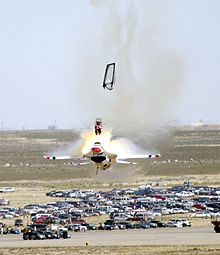 Thunderbird 1st year Capt. Christopher Stricklin ejected from his USAF F-16 aircraft at an airshow at Mountain Home Air Force Base, Idaho, on September 14, 2003. While performing a Reverse Half Cuban Eight, Stricklin realized he could not pull up in time and ejected. Eight-tenths of a second later, the plane crashed, skidding aflame 200 yards, and the engine flew out and went another 100 yards. Except for a few bruises, he was not injured.
Thunderbird 1st year Capt. Christopher Stricklin ejected from his USAF F-16 aircraft at an airshow at Mountain Home Air Force Base, Idaho, on September 14, 2003. While performing a Reverse Half Cuban Eight, Stricklin realized he could not pull up in time and ejected. Eight-tenths of a second later, the plane crashed, skidding aflame 200 yards, and the engine flew out and went another 100 yards. Except for a few bruises, he was not injured.
An aviation accident is defined in the Convention on International Civil Aviation Annex 13 as an occurrence associated with the operation of an aircraft which takes place between the time any person boards the aircraft with the intention of flight and all such persons have disembarked, in which a person is fatally or seriously injured, the aircraft sustains damage or structural failure or the aircraft is missing or is completely inaccessible. The first fatal aviation accident occurred in a Wright Model A aircraft at Fort Myer, Virginia, USA, on September 17, 1908, resulting in injury to the pilot, Orville Wright and death of the passenger, Thomas Selfridge.
An aviation incident is also defined there as an occurrence other than an accident, associated with the operation of an aircraft, which affects or could affect the safety of operations.
An accident in which the damage to the aircraft is such that it must be written off, or in which the plane is destroyed is called a hull loss accident.
Contents
Major disasters
September 11 terror attacks
The deadliest aviation-related disaster of any kind, considering fatalities on both the aircraft and the ground, was the destruction of the World Trade Center in New York City on September 11, 2001, with the intentional crashing of American Airlines Flight 11 and United Airlines Flight 175. The World Trade Center crashes killed 2,752, most of them occupants of the World Trade Center towers or emergency personnel responding to the disaster. In addition, 184 were killed when American Airlines Flight 77 was crashed into the Pentagon and 44 were killed when United Airlines Flight 93 crashed into a Pennsylvania field, bringing the total number of casualties of the September 11 attacks to 2,996 (including the 19 terrorist hijackers). Being deliberate terrorist acts, the 9/11 crashes were not classified as accidents, but as mass murder-suicide, and subsequently treated by the United States and the member nations of NATO as an act of war.
Tenerife
The March 27, 1977, Tenerife disaster remains the accident with the highest number of airliner passenger fatalities. In this disaster, 583 people died when a KLM Boeing 747 attempted take-off without clearance, and collided with a taxiing Pan Am 747 at Los Rodeos Airport on the island of Tenerife, Spain. Pilot error was the primary cause of this catastrophe.
JAL Flight 123
The crash of Japan Airlines Flight 123 in 1985 is the single-aircraft disaster with the highest number of fatalities. In this crash, 520 died on board a Boeing 747. The aircraft suffered an explosive decompression from an incorrectly repaired pressure bulkhead, which failed in mid flight and destroyed most of its vertical stabilizer, and severed all of the hydraulic lines, making the 747 virtually uncontrollable. The pilots were able to keep the plane flying for several minutes before crashing into a mountain. Remarkably, several people survived the impact, but by the time that the rescue teams could get there, all but four had died.
Other crashes with high death tolls
The world's deadliest mid-air collision was the 1996 Charkhi Dadri mid-air collision involving Saudia Flight 763 and Air Kazakhstan Flight 1907 over Haryana, India. The crash was mainly the result of the Kazakh pilot flying lower than the altitude for which his aircraft was given clearance. Three hundred and forty-nine passengers and crew died from both aircraft. The Ramesh Chandra Lahoti Commission, empowered to study the causes, also recommended the creation of "air corridors" to prevent aircraft from flying in opposite directions at the same altitude.
On March 3, 1974, Turkish Airlines Flight 981, a McDonnell Douglas DC-10, crashed in a forest northeast of Paris, France. The destination was London but the plane crashed shortly after taking off from Orly airport. A total of 346 people were on board; all of them perished in the crash. It was later determined that the cargo door had detached which caused an explosive decompression which in turn caused the floor just above to collapse. When the floor collapsed it severed the control cables, which left the pilots without control of the elevators, the rudder and the No. 2 engine. The plane entered a steep dive and crashed. It was the deadliest plane crash of all time until the Tenerife disaster in 1977.
On June 23, 1985, Air India Flight 182 crashed off the southwest coast of Ireland when a bomb exploded in the cargo hold. On board the Boeing 747-237B were 307 passengers and 22 crew members, all of whom were killed when the plane disintegrated. One passenger had checked in as "M. Singh". He did not board the flight, but his suitcase which contained the bomb was loaded onto the plane. "Mr Singh" was never identified and captured. It was later found out that Sikh extremists were behind the bombing and that it was a retaliation for the Indian government's attack on the sacred Golden Temple in the city of Amritsar, which is very important for the Sikhs. This was, at the time, the deadliest terrorist attack involving an airplane.
Iran Air Flight 655 was an Iranian civilian airliner shot down by two surface-to-air missiles from the U.S. Navy's guided missile cruiser USS Vincennes on Sunday, 3 July 1988, over the Strait of Hormuz, killing all 290 passengers and crew aboard, including 66 children, ranking it seventh among the deadliest airline disasters.[1]
On May 25, 1979, American Airlines Flight 191, a McDonnell Douglas DC-10-10, lost control and crashed near O'Hare International Airport in Des Plaines, Illinois, following inproper maintenance and the loss of an engine. The crash killed all 271 passengers and crew on board, as well as two people on the ground. It remains the deadliest single-aircraft accident in United States history, and was also the deadliest aviation disaster until the September 11 attacks in 2001.
On September 1, 1983, a Soviet Sukhoi Su-15 shot down Korean Air Lines Flight 007 after it flew into Soviet airspace, killing all 269 passengers and crew.[2]
On November 12, 2001, American Airlines Flight 587, an Airbus A300, crashed in the Belle Harbor neighborhood of Queens, New York, just after departing John F. Kennedy International Airport due to the first officer's overuse of the rudder in response to wake turbulence from a Japan Airlines 747. The crash killed all 260 people on board, as well as five people on the ground. It is the second-deadliest aviation accident on U.S. soil, after American Airlines Flight 191
Pan Am Flight 103 was a Boeing 747-121 that was destroyed by a terrorist bomb over the town of Lockerbie, Scotland, on December 21, 1988. The crash killed all 243 passengers, all 16 crew and 11 people on the ground (all of whom were residents of Sherwood Crescent, Lockerbie), making it the worst terrorist attack involving an aircraft in the UK. It remains the deadliest terrorist attack on British soil.
On October 31, 1999, at around 01:50 EST, EgyptAir Flight 990 (MSR990) crashed into the Atlantic Ocean, about 60 miles (97 km) south of Nantucket Island, Massachusetts, in international waters, killing all 217 people on board. The National Transportation Safety Board report concluded that the pilot had intentionally dived the aircraft into the ocean; Egyptian authorities have vigorously denied this conclusion, saying that a mechanical failure was to blame.
Safety
Aviation safety has come a long way in over one hundred years of implementation. In modern times, two major manufacturers still produce heavy passenger aircraft for the civilian market: Boeing in the United States of America and the European company Airbus. Both have placed huge emphasis on the use of aviation safety equipment, now a billion-dollar industry in its own right, and made safety a major selling point—realizing that a poor safety record in the aviation industry is a threat to corporate survival. Some major safety devices now required in commercial aircraft involve:
- Evacuation slides — aid rapid passenger exit from an aircraft in an emergency situation.
- Advanced avionics - Computerized auto-recovery and alert systems.
- Turbine engines - durability and failure containment improvements
- Landing gear - that can be lowered even after loss of power and hydraulics.
When measured on a passenger-distance calculation, air travel is the safest form of transportation available: these figures are the ones mentioned by the air industry when quoting statistics on air safety. A typical statement is this one by the BBC: "UK airline operations are among the safest anywhere. When compared against all other modes of transport on a fatality per mile basis air transport is the safest — six times safer than traveling by car and twice as safe as rail."[3]
However, when measured by fatalities per person transported, buses are the safest form of transportation and the number of air travel fatalities per person are surpassed only by bicycles and motorcycles. This statistic is the one used by the insurance industry when calculating insurance rates for air travel.[4]
For every billion kilometers traveled, trains have a fatality rate 12 times larger than air travel, while automobiles have a fatality rate 62 times larger. On the other hand, for every billion journeys, buses are the safest form of transportation. By the last measure, air transportation is three times more dangerous than car transportation and almost 30 times more dangerous than bus.[5]
 After the crash of Gol Transportes Aéreos Flight 1907, Brazilian Air Force personnel recover the flight data recorder of the flight.
After the crash of Gol Transportes Aéreos Flight 1907, Brazilian Air Force personnel recover the flight data recorder of the flight.
A 2007 study by Popular Mechanics found that passengers sitting at the back of a plane are 40% more likely to survive a crash than those sitting in the front, although this article also quotes Boeing, the FAA and a website on aircraft safety, all claiming that there is no safest seat. The article studied 20 crashes, not taking in account the developments in safety after those accidents.[6] However, a flight data recorder is usually mounted in the aircraft's empennage (tail section), where it is more likely to survive a severe crash.
Over 95% of people in U.S. plane crashes between 1983 and 2000 survived.[7]
Statistics
Aircraft Crashes Record Office (ACRO)
The Geneva-based Aircraft Crashes Record Office (ACRO) compiles statistics on aviation accidents of aircraft capable of carrying more than six passengers, not including helicopters, balloons, or fighter airplanes. It should be noted that ACRO is not a government or official organization. The ACRO announced in 2008 that the year 2007 was the safest year in aviation since 1963 in terms of number of accidents.[8] There had been 136 accidents registered (compared to 164 in 2006), resulting in a total of 965 deaths (compared to 1,293 in 2006). Since then, both 2009 and 2010 saw fewer registered accidents, 122 and 130, respectively. 2004 was the year with the lowest number of fatalities since the end of World War II, with 771 deaths. The year with most fatalities was 1972, with 3,214 deaths.
year deaths[9] # of accidents[10] 2010 1,115 130 2009 1,103 122 2008 884 156 2007 971 147 2006 1,294 166 2005 1,459 185 2004 771 172 2003 1,230 199 2002 1,413 185 2001 1,534 200 2000 1,582 189 1999 1,138 211 Annual Aviation Safety Review (EASA)
The European Aviation Safety Agency (EASA) is tasked by Article 15(4) of Regulation (EC) No 216/2008 of the European Parliament and of the Council of 20 February 2008 to provide an annual review of aviation safety.
The Annual Safety Review presents statistics on European and worldwide civil aviation safety. The statistics are grouped according to type of operation, for instance, commercial air transport, and aircraft category, such as aeroplanes, helicopters, gliders etc. The Agency had access to accident and statistical information collected by the International Civil Aviation Organisation (ICAO). States are required, according to ICAO Annex 13 on Aircraft Accident and Incident Investigation, to report to ICAO information on accidents and serious incidents to aircraft with a maximum certificated take-off mass (MTOM) over 2250 kg. Therefore, most statistics in this review concern aircraft above this mass. In addition to the ICAO data, a request was made to the EASA Member States to obtain light aircraft accident data. Furthermore, data on the operation of aircraft for commercial air transport was obtained from both ICAO and the NLR Air Transport Safety Institute.[11]
Investigation
See also: Category:Organizations investigating aviation accidents and incidentsAustralia
The Australian Transport Safety Bureau is the federal government body responsible for investigating transport-related accidents and incidents within Australia. It covers air, sea, and rail travel. It was an agency of the Department of Infrastructure, Transport, Regional Development and Local Government, but in the interests of keeping its independence, in 2010 it became a stand alone agency.
Canada
The Transportation Safety Board of Canada (TSB/BST), an independent agency which reports directly to Parliament, is the Canadian agency responsible for the advancement of transportation safety through the investigation and reporting upon accident and incident occurrences in all prevalent Canadian modes of transportation — marine, air, rail and pipeline.
France
In France, the agency responsible for investigation of civilian air crashes is the Bureau d'Enquêtes et d'Analyses pour la Sécurité de l'Aviation Civile (BEA). Its purpose is to establish the circumstances and causes of the accident and to make recommendations for their future avoidance.
Germany
In Germany, the agency for investigating air crashes is the Federal Bureau of Aircraft Accidents Investigation (BFU). It is an agency of the Federal Ministry of Transport, Building and Urban Development.
Italy
In Italy, the Agenzia Nazionale per la Sicurezza del Volo (ANSV) has two main tasks: (a) to conduct technical investigations for civil aviation aircraft accidents and incidents, and to issue safety recommendations as appropriate; and (b) to conduct studies and surveys aimed at increasing flight safety. The ANSV is under the oversight of the Presidency of the Council of Ministers of Italy.
Russia
The Interstate Aviation Committee (MAK) is an executive body overseeing the use and management of civil aviation in the Commonwealth of Independent States. This Organization investigating air accident in the former USSR area by Air Accident Investigation Commission of the Interstate Aviation Committee.
United States
In the United States, most civil aviation incidents are investigated by the National Transportation Safety Board (NTSB). When investigating an aviation disaster, NTSB investigators piece together evidence from the crash and determine the likely cause or causes. The NTSB will also investigate incidents which occur overseas in collaboration with local investigation authorities where the crash has involved a US-registered aircraft, where there has been significant loss of American lives, or when the type of aircraft involved is built by an American company.
United Kingdom
In the United Kingdom, the agency responsible for investigation of civilian air crashes is the Air Accidents Investigation Branch (AAIB) of the Department for Transport. Its purpose is to establish the circumstances and causes of the accident and to make recommendations for their future avoidance.
In all cases, the organisations do not legally attribute blame to any party involved in an accident. Since they are a safety organisation, they instead list what the most probable cause of the accident was, and steps to prevent the same type of accident occurring again.
Retirement of flight numbers
It is common for an airline to cease using the flight number after a fatal crash.[12] This is not always the case; see, for example, Japan Airlines 123, Aeroflot Flight 593, Aero Flight 311, Iran Air Flight 655, United Airlines Flights numbered 608, 624, and 823, and Aer Lingus Flight 712.
See also
- Category:20th-century aviation accidents and incidents
- Category:21st-century aviation accidents and incidents
- Lists of airliner accidents
- by year
- by airline
- by location
- by death toll
- by cause/in alphabetical order
- Types of accidents
- Fuel tank explosion
- Mid-air collision
- Uncontrolled decompression
- List of aircraft structural failures
- List of airship accidents
- List of accidents and incidents involving commercial aircraft
- List of accidents and incidents involving general aviation (including chartered / non-scheduled passenger flights)
- Lists of military aircraft accidents
- List of accidents and incidents involving military aircraft
- List of aviation shootdowns and accidents during the Iraq War
- List of Coalition aircraft crashes in Afghanistan
- List of C-130 Hercules crashes
- Air safety
- Aviation authorities
- Other
- Accident analysis
- Aircraft hijacking
- Disaster
- List of aircraft shootdowns
- List of people who died in aviation accidents and incidents
- List of sole survivors of airline accidents or incidents
- List of space disasters
- List of airshow accidents
- List of news aircraft crashes
References
- ^ Iran Air 655, House Armed Services Hearing, 21 July 1992
- ^ "1983: Korean airliner 'shot down'". BBC News. 1983-09-01. http://news.bbc.co.uk/onthisday/hi/dates/stories/september/1/newsid_2493000/2493469.stm. Retrieved 2009-06-01.
- ^ "Flying still the safest form of travel". BBC News. 8 May 2000. http://news.bbc.co.uk/2/hi/uk_news/736582.stm. Retrieved 2010-01-01.
- ^ "Flight into danger". New Scientist Space. 7 August 1999. http://space.newscientist.com/article/mg16321985.200-flight-into-danger.html.
- ^ "The risks of travel". numberwatch.co.uk. Archived from the original on 7 September 2001. http://web.archive.org/web/20010907173322/http://www.numberwatch.co.uk/risks_of_travel.htm. Retrieved 26 January 2009. The website attributes the source as an October 2000 article by editor Roger Ford in the magazine Modern Railways and based on an unidentified DETR survey.
- ^ David Noland (18 July 2007). "Safest Seat on a Plane: PM Investigates How to Survive a Crash". Popular Mechanics. http://www.popularmechanics.com/science/air_space/4219452.html?safe.
- ^ Watt, Nick (17 January 2007). "Staying Alive During a Plane Crash". ABC News. http://abcnews.go.com/Nightline/story?id=2619382&page=1. Retrieved 2 December 2009.
- ^ 2007 : excellent year for civil aviation Geneva, 1st January 2008
- ^ Death number by year (ACRO)
- ^ Accident number by year (ACRO)
- ^ http://www.nlr-atsi.nl
- ^ Grossman, David. "Check your travel superstitions, or carry them on?," USA Today
Bibliography
- Accident the world http://accident-mm.blogspot.com/
- KLu Crash Archief; Ongevallenfoto's 1945 - 1965, 'Flash Aviation', 2003.
- KLu Crash Archief 2; Ongevallenfoto's 1964 - 1974, 'Flash Aviation', 2004.
- BLu Crash Archief; Ongevallenfoto's 1945 - 1965, 'Flash Aviation', 2004.
- USAF & NATO Report RTO-TR-015 AC/323/(HFM-015)/TP-1 (2001).
External links
- Aircraft Crashes Record Office based in Geneva, Switzerland
- Aviation Safety Network Established in 1996. The ASN Safety Database contains descriptions of over 12200 airliner, military and corporate jet aircraft accidents/incidents since 1943.
- National Transportation Safety Board Accident Database & Synopses
- Human Error Vs. Airborne Terrorism - editorial citing examples of most severe consequences of pilot error and other human error.
- Computer-Related Incidents with Commercial Aircraft: A Compendium of Resources, Reports, Research, Discussion and Commentary, compiled by Peter B. Ladkin et al.
- Why Aircraft Fail Common causes of structural failure in aircraft components.
- http://www.airdisaster.com/ Air disasters website
- Birds and Airplanes - The comprehensive research that was done in Israel by the IAF and the International Center for the Study of Bird Migration in Latrun
Lists of aviation accidents and incidents By type Commercial Military by year (pre-1925 · 1925-1934 · 1935-1939 · 1940-1944 · 1945-1949 · 1950–1959 · 1960–1974 · 1975–1999 · 2000–present) · Iraq War · USAF · War in AfghanistanOther Deaths Related topics For more exhaustive lists, see the Aircraft Crashes Record Office (ACRO) and Aviation Safety Network websites.
Italics indicates the list is a wikicategory.Aviation accident and incident investigation agencies Africa 
Asia Europe North America Oceania South America Lists relating to aviation General Aircraft (manufacturers) · Aircraft engines (manufacturers) · Airlines (defunct) · Airports · Civil authorities · Museums · Registration prefixes · Rotorcraft (manufacturers) · TimelineMilitary Accidents/incidents Records Categories:- Air safety
- Aviation accidents and incidents
- History of aviation
- Engineering failures
- Lists of aviation accidents and incidents
Wikimedia Foundation. 2010.

